
Gold futures for delivery in March 2017 were about $1,230 per ounce during overnight trading on February 15, 2017. Gold has rebounded significantly over the past few months, primarily fueled by some political risks. Additionally, gold prices snapped a four-day losing streak on Wednesday.
According to Principal and Co-Founder at Altavest, “The precious metals are momentarily disconnected from their usual correlations with outside markets…It could be that gold’s strength is evidence of skepticism of the sustainability of the stock market’s melt-up.”
The rise in gold prices in Wednesday’s trading was primarily attributed to the U.S. dollar’s retreat, and the U.S. Dollar Index pulled back below 101 during overnight trading between February 15 and February 16, 2017. A fall in the U.S. dollar would benefit gold prices and other precious metals.
Trader Jason Bond, who is invested in the VanEck Vectors Gold Miners ETF (NYSEARCA: GDX) in his long-term ETF portfolio, stated, “There could be some volatility in gold prices, primarily attributed to Federal Reserve Chair Yellen. However, there are some political risks in both the U.S. and Europe, which could cause some investors to look to gold and gold miners for safety.”
Germany Is Repatriating Gold
Germany’s Central Bank seems to think gold is still relevant. In an official announcement in early February 2017, the Bundesbank indicated that it repatriated close to half of its gold reserve. Germany’s central bank is looking to bring home its gold reserves stored in New York, Paris and other cities, faster than it planned.
This may be a signal that Germany is afraid of another financial crisis and some political risks. The central bank has already moved over 550 tons of gold from New York and Paris, and the Bundesbank is looking to have half its gold reserves back in Germany by the end of this year.
Can Political Risks Boost Gold?
The first round of the French Presidential will be held on April 23, 2017, and there are some political risks. French Presidential candidate Marine Le Pen is adding some volatility to the currency markets, and she has been calling for France to leave the Eurozone and discontinue its use of the euro.
Le Pen stated, “The euro isn’t a currency, it’s a political weapon. The euro is a knife which the EU puts into the backs of the people to force them to go where they don’t want to go…Either the EU gives French people back their territorial sovereignty, borders, control over their economy, control over their currency and the superiority of their laws, or I will say to the French people that we should leave the EU.”
Based on Le Pen’s comments, there is Frexit risk on the table. With the U.K. leaving the EU just last year, if France leaves the EU, it could be detrimental to the union and the euro. That being said, if this occurs, many investors could flock to gold as a safe haven. However, some investors are not taking the Frexit risk seriously. If Le Pen wins the French Presidential election, the country could withdraw from the euro, which would add to political and economic risks, and in turn, gold prices could rise.
The Bottom Line
Gold prices is still trading above $1,200 an ounce and the yellow precious metal could continue higher. The Frexit risk could cause some investors to pay more attention to the French Presidential election. If market participants begin to take note of the risk of France leaving the EU, some investors may flock to gold as a safe haven.

The early stages of Gold bull markets (this one included) are characterized by strong outperformance from the miners. They will lead the metals and turning points and register strong outperformance. We saw that in the early 2000s, late 2008 to early 2009 and we have seen it again over the past year. During the recent rebound, the miners rallied back to the “Trump” resistance while Gold is not yet close to doing so. However, unfortunately for bulls, while Gold is now pushing higher above key levels, the gold stocks are lagging. This new and recent underperformance suggests the gold stocks have made an interim peak and will remain entrenched in a correction or consolidation.
In the daily bar chart below we plot Gold, GDX and GDXJ. Gold closed the week up 1.6% and through resistance at $1250/oz while both GDX and GDXJ closed down over 2.5%. That is a strong negative divergence. Gold also eclipsed its early February high while miners did not. Do note that the miners already reached their early November peak (GDXJ exceeded it) while Gold remains some $40/oz below that peak. Buying in the miners reached an exhaustion point.
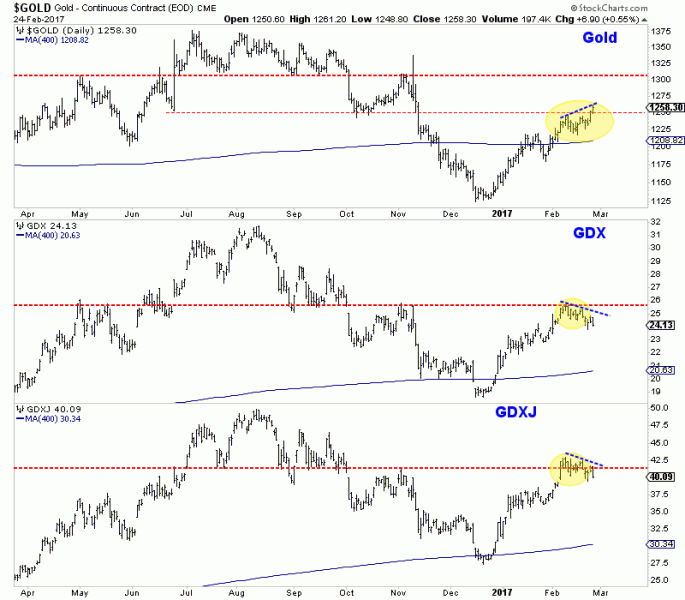
So if the gold stocks are correcting, how much downside potential is there? Upon first glance, we see 8% downside for GDX and 10% to 12% downside for GDXJ and TheDailyGold junior index. Note that the miners have already corrected roughly 6% to 9%. Keep an eye on GDX $22 because it is a confluence of strong support. It includes the 400-day exponential moving average which has provided support during many bull market corrections. The same can be said for the 350-day exponential moving average for TheDailyGold junior index. The secondary downside target for GDX and GDXJ would be the 400-day moving averages which are currently at $20 and $30 and rising.
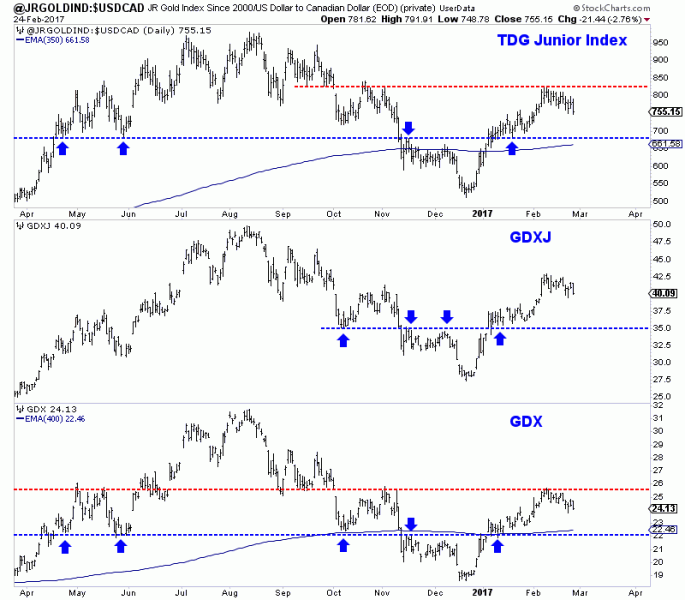
After a roughly 40% to 50% rebound in only two months it should be no surprise that the mining sector has begun to soften around important resistance. Therefore, the recent underperformance in the shares relative to the metals (Silver included) rather than a surprise is confirmation that a correction in the shares has begun. We expect the metals to follow suit soon enough. Investors and traders are advised to accumulate their favorite names as the mining sector nears our downside targets.

The Australian Stock Exchange (ASX) is home to the most actively-traded indices in the Asia Pacific region. Among the many sectors in the ASX, the Metals & Mining sector ranks highly. At last count, there were some 700+ ASX listed companies involved in mineral exploration, production, and development across 100 countries. Top-tier ASX companies include Rio Tinto and BHP Billiton. There are also junior mining companies and mid-tier production companies
in the mix.
The ASX is home to some of the world’s biggest metals, mining and commodity listed companies, and investors from all parts of the world are engaged in ASX trading. Since 2009, domestic investors and foreign investors have been instrumental in securing 270+ additional junior resource flotations on the ASX. Examples of top-listed mining companies on the ASX include Wolf Minerals Limited, Cudeco Limited, Teranga Gold Corporation, Iluka Resources Ltd., Anglogold Ashanti Ltd, and Sims Metal Management Limited.
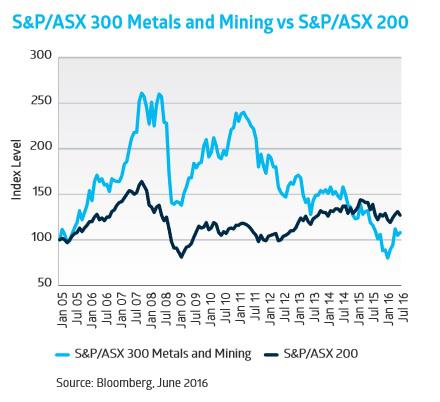
The top 5 mining company stocks on the ASX include the following (subject to fluctuation):
- BHP Billiton Limited with a market capitalization of $98,643.9 million
- Rio Tinto Limited with a market capitalization of $77,823.4 million
- Alcoa Inc. with a market capitalization of $17,227.9 million
- Fortescue Metals Group Limited with a market capitalization of $12,642.0 million
- Newcrest Mining Limited with a market capitalization of $18,495.9 million
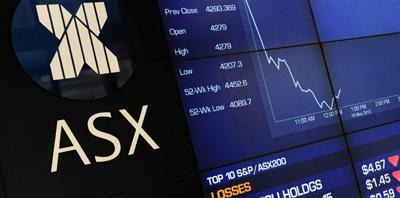
These companies are the leaders in diversified metals and mining, aluminum, steel, and gold. Investors looking to profit off the price movements in the metals and mining sector of the ASX can do so easily. Further, these stocks are the perfect alternative to exchange traded funds (ETFs). For example, there are 14 Australian stock exchange companies available to be traded with the metal lithium. These include the following tickers: CAG, CNY, PLP, AJM, MZN, LIT, ENL, LTX, GXY, BGS, ORE, NMT, PSM, CXB, TKL, PLS, RNU. Much the same is true for gold mining companies, platinum companies, iron ore, silver and others. Overseas investors looking to cash in on the lucrative ASX and its array of mining companies will do well to transfer money to Australia, to invest in these mining stocks. The way this is done is laid out under the services as described in sendmoneyaustralia.com. Small businesses in Australia, Australians living abroad, and others can easily transfer money to Australia, typically within 2 – 3 working days. The benefits of using money transfer services for investment in the ASX are tremendous cost savings on FX rates.
What Sort of Returns are Possible on Mining Stocks?
The early part of 2016 was characterized by lackluster performance in mining stocks. However, as China’s economic performance began to strengthen so demand for silver, gold, iron ore and other mineral resources increased. The future of metals like lithium is bright indeed. That’s why investors around the world are touting lithium as the must-have asset in a financial portfolio. The most important reason for lithium’s bullish prospects are electric vehicles. Lithium is a key component in electric vehicles, and for this reason demand for this element is going to increase sharply.
Australia is a first world country with a huge mining sector. The massive scale of mining operations down under accounts for AU$28,476 million of Australian GDP as at Q3 2016. The total value of Australian GDP is US$1,339.54 billion. Therefore mining accounts for approximately 1% – 2% of Australian GDP. Just a couple years ago, that figure was closer to 8.5% when the price of precious metals was much higher. Nonetheless, a strong uptick is expected what with a resurgent US economy and China on the mend. This will boost the prices of precious metals and industrial metals in Australia. Traders will do well to cash in on these opportunities while the market is in correction mode. Few, if any, markets provide traders with as much earning potential as the ASX in the mining sector. It is a largely untapped pool of profit waiting to be generated.
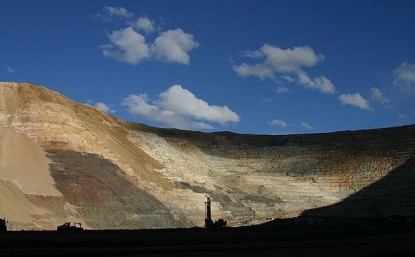
Zinc was the second-best performing commodity in 2016, with a staggering 65.7% return.
The greyish metal primarily used in galvanizing steel is off to a hot start in 2017, up another 12.5% to $1.30/lb.
“For us zinc is still the most exciting story out there “ Don Lindsay, President and CEO, Teck (January 26, 2017)
The reason for the zinc price rise is one of the basic principles of economics – supply and demand.
Zinc inventories (supply) have been falling like a rock. Inventories last February on the LME were ~500,000 tonnes and are now down to ~380,000 tonnes.
Two of the largest zinc mines in the world have closed in the last few years (Century and Lisheen) due to ore depletion, removing ~4 % of world supply.
The world’s largest mining company, Glencore, significantly helped the zinc market as well cutting production by 500,000 tonnes in late 2015. The cuts were made because of the low price of zinc at the time. Glencore has yet to restart production at these mines and this will be a major factor for investors in zinc to keep an eye on.
Zinc demand has steadily increased throughout the last several years and and is expected to increase by 2.1% to 13.85 million tonnes in 2017.

The zinc price is now at a 5 year high of $1.30 per pound as inventories are also near a 5 year low at ~380,000 tonnes (LME). Shanghai Futures Exchange stocks have also declined substantially in the last 3 years.
How high can zinc go in 2017?
As inventories continue to decrease along with no new mine supply expected, a pinch point appears to be coming for the zinc price.
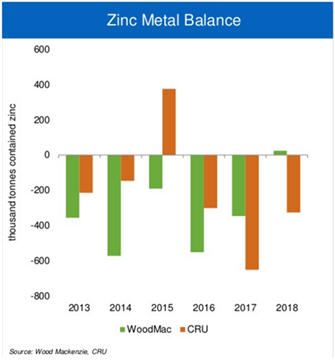
“The next two years, 2016 and 2017, represent the ‘pinch point’ of concentrate supply, with mine-closure related cuts expected to outweigh new output from projects.” Wood Mackenzie Analyst, Jonathan Leng.
Zinc price forecasts
- Scotiabank is forecasting zinc prices to average $1.35/lb in 2017 and $1.55/lb in 2018.
- Wood Mackenzie, a leading research firm has a peak price target of $4000 US/tonne ($1.80 per lb) in 2018.
- Bank of Montreal has forecasted an average price of $1.50 per lb from 2017-2019.
If these forecasts are anywhere near correct, the zinc price still has tremendous upside from current levels.
The best way for investors to play a zinc price move would be to invest in zinc equities.
“I definitely think it is the right time to do so [invest in the zinc market]. About the only way to do so is through zinc equities, whether you’re looking at the major producers or some of the junior explorers there are not a lot of options out there for zinc.” Brien Lundin, editor of the Gold Newsletter
Investors have three different ways to play an investment in zinc stocks – producers, developers, and explorers.
Here are 3 companies on my radar.
Producers
Investors looking for a large cap company in the zinc space would have to have Teck (TCK.B:TSX) on the top of their list. Teck is the world’s third largest zinc producer and receives approximately ⅓ of its revenue from zinc.
Taking a step down and looking for a cheaper option in the mid-cap range would be Trevali Mining (TV:TSX). Trevali is a pure-play zinc producer with two operating mines. Trevali produced ~98 million pounds of zinc in 2016, along with lead and silver.
Analyst Joseph Gallucci of Dundee Capital Markets has TV rated as a top pick on leverage to zinc and “based on current production, as well as short-term organic growth.” Bank of Montreal has just initiated coverage with analyst Alex Terentiew putting a $2 target price on Trevali shares.
Zinc developer
The team at Darnley Bay (DBL:TSX.V) realized that the zinc market was heading for a supply/demand deficit and started looking for development stage projects.
The team acquired two of the most advanced stage development projects in the world – Pine Point and Clear Lake. Kerry Knoll, Executive Chairman and director has had his eye on the Point Project for years and was excited to acquire a development stage project with resources in the ground.
“When Cominco left in the late 1980s, they left a number of deposits behind that they considered too low grade, and they had other projects to mine instead.” says Knoll.
“Leaving them behind gives us a really great head start towards building a mine.”
The acquisition of Pine Point was significant, as it is a past producing zinc district in Yellowknife.
President and CEO of Darnley Bay, Jamie Levy had this to say on the acquisition, “Pine Point has historic size, it’s got grade – which we think is economic at today’s prices – it’s got phenomenal infrastructure, a good jurisdiction in Canada, willing aboriginal partners and exploration upside.”
Pine Point was the most profitable lead-zinc mine in Canadian history and was shut down in 1987 due to low zinc ($0.35/lb) and lead ($0.27/lb) prices. Between 1965-1987, Cominco mined 64 million tonnes of 7% zinc and 3.1% lead from 52 ore deposits.
Current zinc resources at Pine Point are 4.2 billion pounds in 46 deposits left by Cominco.
Zinc primary deposits are formed in the three different deposit models.
1. Mississippi Valley Type (MVT)
2. Sedimentary Exhalative Deposits (SEDEX)
3. Carbonate Replacement Deposit (CRD)
The Pine Point property hosts Mississippi Valley Type (MVT) deposit(s) which is important for investors to note. MVT deposits are important sources of lead-zinc that account for ~24% of global lead-zinc resources. MVT deposits are valuable, typically high grade with non-complex metallurgy. The systems typically have less iron than SEDEX and CRD deposits. This is fetches a premium as when the ore goes to the smelter, it will be less penalized.

Darnley Bay’s zinc land package consists of 46 deposits that contain 48 million tonnes of historical resources. Excellent potential remains to increase these resources. Greenfield exploration is also exciting with 34 geophysical anomalies that require further work.
It is important for investors to note the size of the Darnley land package (~62 kilometers) as MVT type deposits tend to be smaller (sub 8 million tonnes), but they occur in districts where there can be hundreds of them. It is likely that more deposits are to be found on this land package.
The R-190 deposit is fully permitted with Cluster and N-204 expected to take 2 years to permit.
Darnley has raised over $10 million from investors in the last couple months. Recent shareholders include Rob McEwen, Lukas Lundin, Pat DiCapo, and Fabrice Taylor.
Fabrice Taylor of The President’s Club newsletter discusses Darnley Bay on BNN (Dec 1st,2016)
2017 is expected to be a busy year for Darnley Bay, with an updated technical report, near mine drilling, regional exploration drilling, and a updated PFS study all on the agenda. If all goes according to plan, production could commence in 2019.
The bottom line is that Pine Point is a brownfield opportunity for investors with excellent greenfield exploration potential.
View the Darnley Bay website at http://www.darnleybay.com and add the symbol DBL on the TSX Venture to your watchlist.
Guest Post Author: James Fraser

Gold stocks are on fire this year, powering higher in market-dominating performance. This is a massive reversal from their dark fourth quarter, with 6/7ths of those losses already erased. But this strong new upleg still remains young and small by historical standards. Gold stocks’ recent rally is only the vanguard of another major bull-market upleg. This sector’s bullish technicals reveal vast upside potential from here.
The gold miners are a small contrarian stock-market sector that isn’t widely followed. Hearing about how the gold stocks are faring in the mainstream financial media is pretty rare. So this sector generally flies under the radars of the great majority of speculators and investors. That’s rather unfortunate, because the gold stocks have enjoyed some of the greatest gains in all the stock markets in this young century.
The flagship gold-stock index is the NYSE Arca Gold BUGS Index, which trades under the symbol HUI. BUGS stands for Basket of Unhedged Gold Stocks, as major gold miners can’t be included in the HUI unless their gold production is not hedged beyond 1.5 years. Running all the way back to June 1996, and having no management fees like ETFs, the HUI offers the definitive read on gold-stock performance.
Today’s leading gold-stock trading vehicle, the GDX VanEck Vectors Gold Miners ETF, closely mirrors the HUI’s price action. Since there aren’t that many major gold miners, GDX’s composition is similar to the HUI’s by necessity. But because GDX charges a 0.52% annual management fee, and its managers change around its components and their weightings so much, the HUI remains the gold-stock metric of choice.
All speculators and investors should pay attention to gold stocks because their bull markets and uplegs multiply wealth like no other sector. Their last secular bull ran between November 2000 and September 2011. During that 10.8-year span, the HUI skyrocketed 1664% higher while the broad-market S&P 500 slipped 14% lower! Secular bull markets in gold stocks truly create life-changing dynasty-building wealth.
Last year another major gold-stock bull market was stealthily born, that has great potential to go secular and get huge. Despite their rotten fourth quarter, the gold stocks as measured by the HUI still blasted a market-leading 64.0% higher in 2016! That compares to a mere 9.5% gain in the S&P 500. So with the HUI already up 21.5% year-to-date in young 2017, speculators and investors alike really need to take notice.
All this gold-stock behavior over the past year or so has been textbook early-secular-bull stuff. And if a new secular bull is indeed underway, the gains in gold stocks in the coming years are going to radically dwarf those seen since early 2016. This first chart looks at this young gold-stock bull in HUI terms since last January. This sector’s technicals have turned really favorable again following the fourth-quarter anomalies.
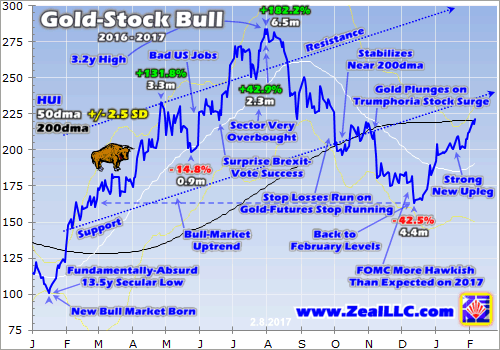
Just over a year ago in mid-January 2016, the gold miners’ stocks had been left for dead. Traders had abandoned them to such an extreme degree that the HUI slumped to a fundamentally-absurd 13.5-year secular low. Gold-stock prices had collapsed back to July 2002 levels, when gold was trading near $305 and had yet to exceed $329 in its young secular bull! But last January gold was 3.6x higher at $1087 at worst.
Just like the rest of the stock markets, gold-mining stock prices must ultimately reflect some reasonable multiple of underlying corporate profits. Back in Q4’15 as traders fled gold stocks, the average gold price was $1105 which was the worst quarter since Q4’09. Yet the elite gold miners of GDX still reported average all-in sustaining costs of just $836 per ounce. They remained very profitable even in gold’s trough quarter.
So a major new bull market was born for fundamental reasons right at the peak of extreme bearishness. Within just 6.5 months, the HUI had rocketed 182.2% higher to a 3.2-year high! Contrarian speculators and investors smart enough and tough enough to buy gold stocks when they were loathed nearly tripled their capital in a half-year. Incredibly 2017 has the potential to see another similar mighty gold-stock upleg.
Gold-stock enthusiasm was getting too rampant last summer, so a major correction was inevitable. Such selloffs are essential to keeping bull markets healthy, bleeding off excessive greed to restore balance to sentiment. Indeed this red-hot sector fell sharply in August before starting to grind higher off a lower base in September. The gold stocks were looking bullish again after plunging 22.0% in less than a month.
But unfortunately Q4’16 proved full of weird market anomalies. Gold stocks were hammered even lower in three separate mass-stopping events. These are normally very rare, so suffering a few of them in a single quarter is phenomenally unlucky. But one hard lesson all traders must learn is how essential it is to just roll with the punches. When markets decouple from reality on sentiment, keep your eyes on fundamentals.
In early October the HUI plunged another 13.0% in three trading days as cascading stop-loss selling was triggered by gold. As gold slipped through major support at $1300, gold-futures speculators’ own stop losses started tripping on their hyper-leveraged positions. The resulting mass stopping was devastating to gold-stock sentiment, as it erupted from correction lows after gold stocks had already sold off considerably.
But the oversold gold stocks soon bottomed and started rallying higher along their key 200-day-moving-average support in October. This fast recovery proved that extreme early-October selling was just an anomaly with no fundamental justification. The gold stocks rallied on balance along their bull-market uptrend’s support line until early November. Then Trump’s surprise election win sparked great market upheavals.
For months leading into that election, all market indications were that stock markets would sell off while gold rallied if Trump somehow pulled off a victory in defiance of the polls. As the early results came in on Election Day’s evening, gold rocketed 4.8% higher from that day’s close in futures trading. The big gold stocks trading live in Australia were up 15%+! Stock markets were plunging, with the S&P 500 down 5%.
But after Clinton apparently conceded early the next morning, big buyers started to flood into stock-index futures. As stock markets turned around and then started to surge in their incredible Trumphoria rally, gold lost its luster. Gold is the anti-stock trade that tends to move counter to stock markets. So when the stock markets appear to do nothing but rally, gold investment demand all but collapses thus gold prices fall.
So a couple days after the election as euphoric stock traders dumped gold positions, the HUI plummeted another 15.2% in just two trading days! That was another snowballing mass stopping, an anomaly driven by an exceedingly-unlikely event. Not only did Trump the underdog win, but contrary to months leading in stock traders suddenly decided capricious Trump was fantastic for stocks. That’s a once-in-a-lifetime surprise.
Yet again the anomalous, sentiment-driven nature of gold stocks’ plunge soon became apparent. This sector immediately stabilized and started drifting sideways near lows despite ongoing heavy gold selling by stock investors. The HUI ground sideways until mid-December, when a third mass stopping in Q4 was triggered by the Fed proving more hawkish than expected by predicting three more rate hikes in 2017.
That took the HUI’s total loss to an extreme 42.5% in just 4.4 months! In Q4 alone this leading gold-stock index had plunged 21.1%. That left speculators and investors alike super-bearish on this sector, totally deluded by groupthink sentiment and blinded to the actual fundamentals. That was a serious mistake. The traders smart enough to get rich in the markets know extreme fear is irrational, fleeting, and marks major bottoms.
Despite stock investors’ heavy selling of gold via GLD gold-ETF shares in Q4, gold still averaged $1218 last quarter. Yet in the preceding Q3’16, which is the latest data available, the major gold miners of GDX averaged all-in sustaining costs of just $855 per ounce. That meant this sector was still running hefty operating profits around $363 per ounce! Thus it was ludicrous for gold stocks to be priced for profits collapsing.
So back in late December soon after that hawkish Fed surprise we made one of our most-aggressive gold-stock and silver-stock deployments ever. We bought and recommended a bunch of great precious-metals miners trading at ridiculously-low prices relative to their underlying earnings. That contrarian bet has already proven wildly profitable in the form of massive unrealized gains over the past 7 weeks or so.
While the gold miners’ Q4 operating results generally aren’t out yet, this industry’s all-in sustaining costs are likely to remain largely in line with the couple preceding quarters’ $886 and $855. That will prove gold mining remained very profitable last quarter even while that improbable series of anomalous mass stoppings fueled hyper-bearish sentiment. Gold stocks’ strong upleg since is absolutely fundamentally justified!
As of the middle of this week, the HUI has already surged 35.5% higher out of its deep mid-December low. That once again trounces the S&P 500’s meager 1.4% gain over that span. Yet all the gold stocks have done so far in their strong new upleg is reverse those anomalous post-election losses. This sector has merely mean reverted back up to its 200-day moving average, where it was trading before Trump won.
This 200dma challenge is crucial, as an upside breakout will convince a lot of speculators and investors on the sidelines that this new upleg is the real deal. A year ago in early February, buyers started to flood into this sector once the HUI blasted back over its 200dma. This particular long moving average is often the most-important support line in any bull market. A decisive 200dma breakout should ignite big upside momentum.
Even on a short-term basis only considering this past year’s young gold-stock bull, this sector has lots of room to run higher from here. The HUI needs to rally another 28% just to regain its August 2016 high, and that was still really low in the grand scheme. The upper resistance line of this young bull market’s uptrend is even higher, up around 305 or so. The gold-stock technicals still look very bullish from here.
But a mere single-year perspective is myopic considering what gold stocks have been through, really failing to do justice to their vast upside potential. This next chart zooms out to the preceding bear market between late 2011 to late 2015. Despite already nearly tripling in the first half of last year, this battered sector’s young bull remains quite small. Gold-stock price levels are still very low by historical precedent.
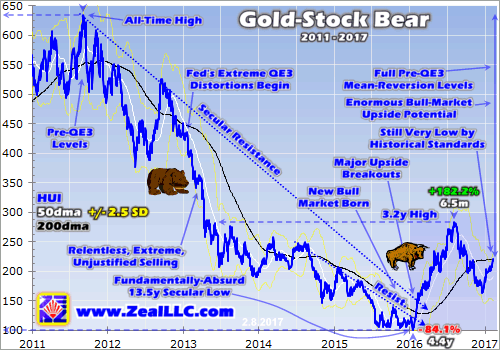
If market history proves one thing, it’s that markets are forever cyclical. Bulls are invariably followed by bears, and they tend to be proportional. This critical core truth has been forgotten by stock traders today, as they are all caught up in the extreme Trumphoria. Big bulls always yield to big bears and vice versa, as nothing rises or falls forever. The gold stocks are early-on in a new bull destined to grow to great size.
Following their last secular bull where they skyrocketed 1664% higher in a little over a decade ending in September 2011, this sector collapsed into a brutal 84.1% bear market that ran 4.4 years. That too was an anomaly, the result of wildly-unprecedented extreme Fed easing. Back in late 2012 the Fed ramped up its new third quantitative-easing campaign to full steam. QE3 was a very different beast from QE1 and QE2.
Unlike its predecessors, QE3 was open-ended with no predetermined size or end date. This worked to ignite an incredible and dangerous stock-market levitation. Whenever the stock markets started to sell off in a healthy and overdue correction, Fed officials would rush to assure traders that they were ready to expand QE3’s bond monetizations if necessary. This extreme dovishness quickly truncated nascent selloffs.
Thus stock traders came to believe that the Fed was effectively backstopping the stock markets. So they abandoned prudent portfolio diversification, which counter-moving gold is the cornerstone of. Heavy differential GLD-share selling persisted for years as investors shunned gold to move even more capital into their already-stock-dominated portfolios. The gold stocks suffered relentless extreme selling as gold fell.
Since gold investment demand and therefore gold prices are so dependent on stock-market fortunes, gold’s performance between 2013 to 2015 was largely the mirror image of the S&P 500’s. And the gold stocks, with earnings almost totally dependent on the gold price, leveraged gold’s losses. But the bear market in gold stocks couldn’t last forever any more than this bull market in general stocks can, as 2016 proved.
Out of that extreme fundamentally-absurd 13.5-year secular low, gold stocks started powering higher in early 2016 as heavy gold buying returned. That was in response to the first real stock-market corrections seen in almost 4 years thanks to the Fed actively suppressing stock-market selling through aggressive dovish jawboning. Those falling stock markets rekindled major gold investment demand for the first time in years.
The gold stocks naturally followed gold, which overwhelmingly drives their profits, higher. They soon broke out from a short-term resistance line and then major secular resistance. But despite their huge upleg in the first half of 2016, the HUI still merely regained mid-2013 levels. Those were still really low in historical context, the result of gold’s extremely-anomalous plunge as the Fed jawboned stock markets higher.
At this week’s HUI levels near 220, this leading gold-stock index remains not far from deep bear-market lows. This sector is trading at late-2014 levels, which were super-depressed by excessive bearishness. So the gold stocks continue to have vast upside potential as they mean revert out of an extreme bear that was fundamentally unjustified into a proportional subsequent bull. Consider a couple of recent ranges.
Back in 2012 which was the last year before the Fed’s extreme QE3 distortions sent markets haywire all over the world, the HUI averaged 465. In order to regain those levels, the gold stocks as a sector would have to rally another 110% from this week’s levels! Is there any other sector in all the stock markets with easy potential to double from here given the lofty stock prices and accompanying euphoria? Not a chance.
In 2011 when gold investment was a lot more normal, the HUI averaged 551. That’s about 150% above current levels. Since bear markets are usually followed by proportional bulls, this young gold-stock bull is very likely to prove secular and fully regain 2011 levels. Of course such a huge mean reversion will require higher gold prices. Nothing gets traders more excited about buying gold stocks than higher gold.
Gold itself has embarked on its own mean reversion higher out of its deep 6.1-year secular low of late 2015. Today gold is poised for big new buying from its two primary drivers, American stock investors and American futures speculators. The stock investors buy gold through GLD gold-ETF shares. Since they dumped gold so aggressively on that Trumphoria stock-market rally, they are radically underinvested now.
So they will have to do big gold buying in the coming months and years to try and re-diversify their stock-heavy portfolios. Provocatively that just got underway this month, with GLD shares enjoying strong differential buying pressure for the first time since the election! That will accelerate dramatically as these overvalued, euphoric stock markets inevitably start rolling over into their long-overdue next bear market.
And the futures speculators’ long positions, their upside bets on gold, are still very low. Thus these traders have tons of room to buy and really bid gold higher as they reestablish normal long levels. In addition to higher gold prices, another major driver of that futures buying will be the lofty US dollar continuing to fade from its recent 14.0-year secular high. Trump’s people will talk down the dollar to boost US exports.
As gold itself continues mean reverting higher out of recent years’ bearish extremes, the gold miners’ stocks will amplify its gains like usual. Gold-mining profits are highly leveraged to gold prices, so higher gold prices quickly translate into much-greater earnings. This critical fundamental underpinning of this young gold-stock bull and its strong new upleg will help the former grow to massive secular proportions.
While speculators and investors alike can certainly play gold stocks’ big coming gains with the major ETFs like GDX, the best gains by far will be won in individual gold stocks with superior fundamentals. Their upside will trounce the ETFs’, which are burdened by over-diversification and underperforming gold stocks. A carefully-handpicked portfolio of elite gold and silver miners will generate much-greater wealth creation.
The bottom line is gold stocks’ strong new upleg is only just starting. Despite enjoying market-leading 2017 performance, all this sector has done so far is reverse the anomalous extreme post-election losses. Gold mining almost certainly remained very profitable even in dark Q4, which means the gold stocks are way undervalued fundamentally relative to their current earnings power. And that will soar as gold rises.
Gold itself is poised to see big buying from stock investors and futures speculators returning after fleeing en masse last quarter. Higher gold prices will lead to much-higher gold-mining profits, strengthening the fundamental foundation of gold stocks’ young new bull and upleg. And with gold stocks remaining so low historically, this bull has excellent potential to grow to secular proportions greatly multiplying wealth.

Gold has underperformed both in nominal and real terms. Last week it formed a bearish reversal in nominal terms and against foreign currencies. However, the good news for bulls is the US Dollar Index lost support at 100, due to the Trump administration’s tough talk against Germany (and the Euro). Couple that with no movement from the Fed and the greenback should continue its decline, thereby juicing the current rebound in Gold and especially gold stocks.
Take a look at the daily candle charts in the image below. We plot the US Dollar index, the Dollar/Yen cross and the 10-year Treasury yield. The US Dollar index has a potential measured downside target of 97 which happens to coincide with a confluence of moving average support. Dollar/Yen has not broken its corrective lows yet but if it does it would strengthen the odds the US Dollar index falls to 97. Meanwhile, the 10-year yield has some more room to fall if its correction were to continue. In short, lower levels on all these charts is short-term bullish for precious metals.
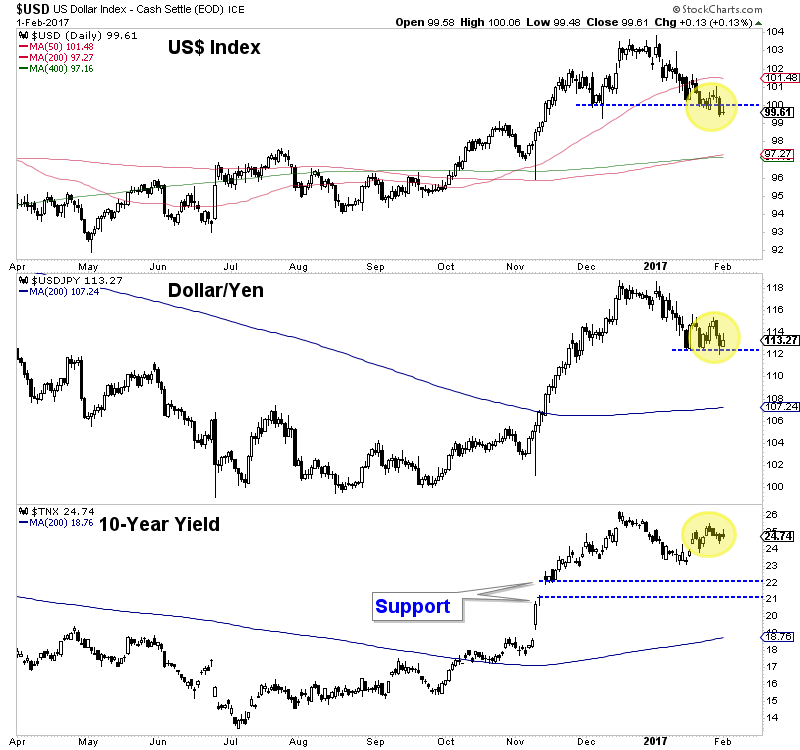
The daily candle chart below shows GDXJ and GDX. The 200-day moving average has held GDXJ but it has a great chance to continue its rally up to $40-$41. GDX could reach $25-$26.
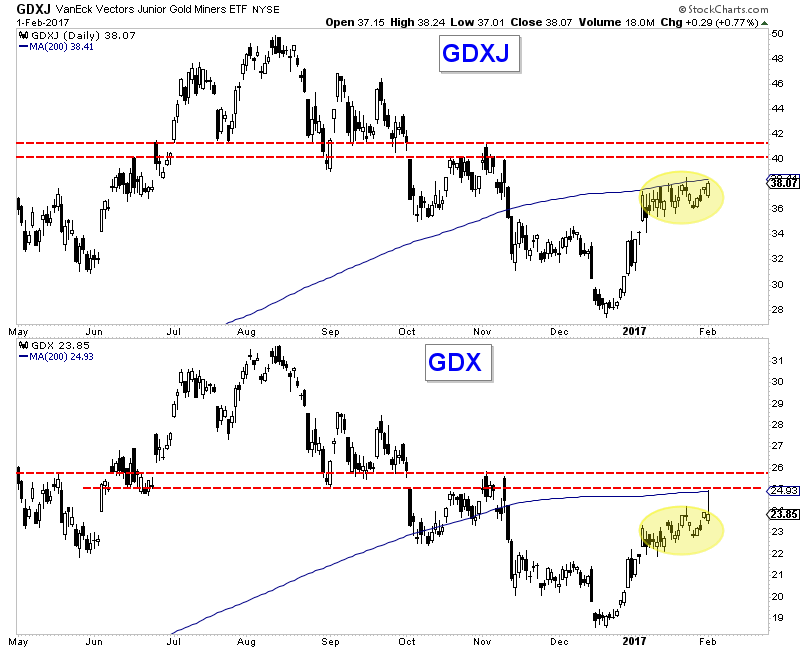
Take a look at a weekly chart and you will notice the significance of those aforementioned targets. The bar weekly charts of GDX and GDXJ are shown below. GDX $26 and GDXJ $41 mark the strongest resistance moving forward. Those levels have been tested 8 times in the past four years compared to the 2013 and 2016 highs which have been tested only 3 times. It’s unlikely the miners break resistance ($26 and $41) on the first try.
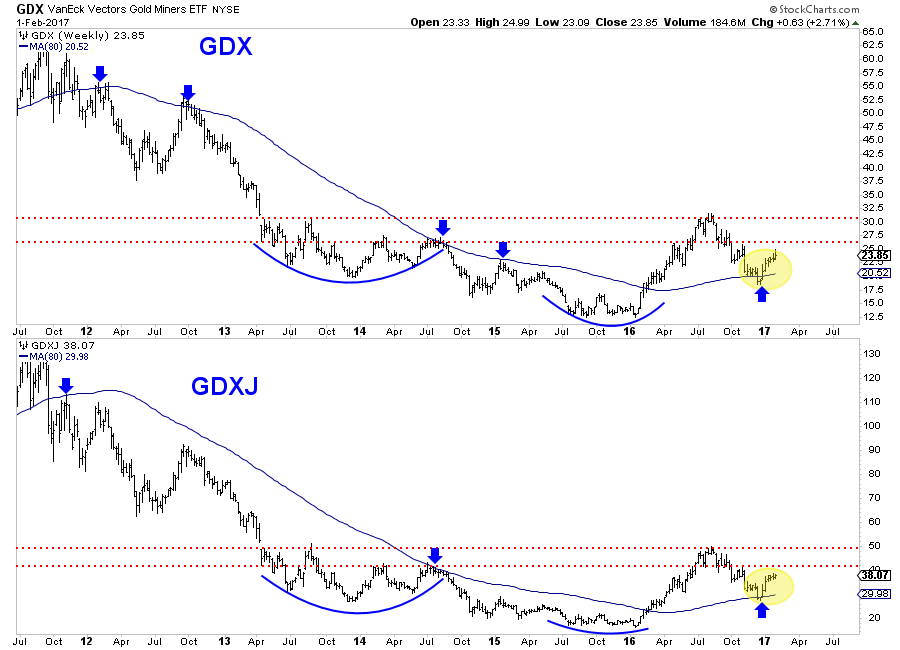
The miners continue to lead as they are on the cusp of higher highs in this recovery while Gold is further away from breaking its resistance at $1220. As we noted in our last missive, a pullback from resistance (the upside targets) is likely. The question though is will the pullback be something bullish or will it evolve into a multi-month correction? We have accumulated a number of juniors gradually but are maintaining some cash in advance of the next correction.
If you would like to receive our free newsletter via email, simply enter your email address below & click subscribe.
CONNECT WITH US
Tweets
Tweet with hash tag #miningfeeds or @miningfeeds and your tweets will be displayed across this site.
MOST ACTIVE MINING STOCKS
Daily Gainers
 Lincoln Minerals Limited Lincoln Minerals Limited |
LML.AX | +125.00% |
      |
GCR.AX | +33.33% |
      |
CASA.V | +30.00% |
      |
AHN.AX | +22.22% |
      |
ADD.AX | +22.22% |
      |
AZM.V | +21.98% |
      |
NSE.V | +21.05% |
      |
DYG.V | +18.42% |
      |
AAZ.V | +18.18% |
      |
GLA.AX | +17.65% |

 Follow us on Twitter
Follow us on Twitter Become our facebook fan
Become our facebook fan








